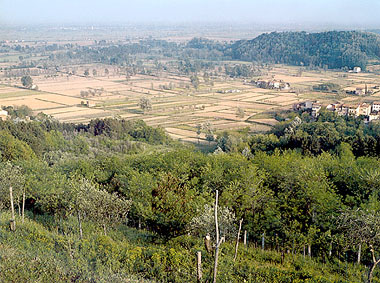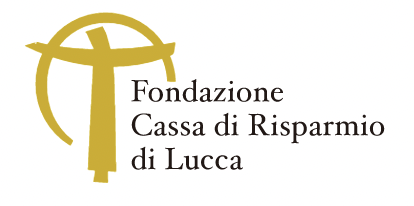
According to the Roman historian Tito Livio and confirmed by recent archaeological finds, Lucca was founded in 180 b.C. as a Roman colony and subsequently, in 89 b.C., a Roman municipality. The town, situated on a lesser branch of the Auser, was fortified and at the beginning represented an important strategic and military centre guarding the surrounding territory, theatre of fierce battles between Romans and Ligurians just a few years earlier.
The foundation of the town was accompanied by a complete reorganisation of the territory, divided into many parts called "centurie", that were intensely cultivated and inhabited by Roman farmers; the plain of Lucca, crossed by a net of roads and canals, became once again fertile and densely populated..
When in 89 b.C., after the conclusion of the civil war, Lucca became a Roman municipality, it received full Roman citizenship and was registered in the tribù Fabia. Between 41 and 27 b.C. the town that already possessed a large number of buildings was provided with a theatre, while the buildings around the forum were restored and received marble façades, probably on initiative of the new colonists.
A crisis that hit not only the urban population, but also the rural settlements, occurred in the second half of the Ist century a.D., when the construction of an amphitheatre could be completed only thanks to the financial intervention of a private citizen. In the course of the IInd century a.D. many buildings inside the town were abandoned and many farms deserted.
After this crisis, in the IVth century Lucca, seat of an imperial manufacture of arms, expanded around its cathedral in the south-eastern part of the town that became the town's new political and religious centre after the area of the forum was abandoned. The revival in Late Antiquity, accompanied by a reorganisation of the agricultural settlements spared from the gradual swamping of the plain, was probably favoured by the survival of the original town walls that constituted an efficient defensive system. Conquered after a long siege in 553 by the Byzantines, Lucca was later occupied by the Lombards at the end of the VIth century and as it was a stronghold and important road junction became the capital of Lombard Tuscia.
Details:
Since the first years following the foundation of Lucca the Roman settlers had been occupied with the construction of walls and other public buildings; the period of major expansion of private buildings, however, was in the Ist century B.C. Archaeological finds from private houses built of the Late Republicperiod are quite numerous, though fragmentary and scattered over the whole area within the walls; they show that the process of urbanisation was probably completed in the Augustean Age.
Generally the walls were made of small blocks or slabs of roughly hewn limestone, while the pavements were usually made of "cocciopesto", sometimes with geometrical decorations in black and white mosaic technique, like the pavement removed in the nineteenth century from the area around the church of S.Reparata and exhibited in the museum of Villa Guinigi; at other times stone fragments were inserted, like in the pavement found at palazzo Ansaldi.
The so called "scutulatum" technique, with the insertion of polychrome stone fragments in mosaic backgrounds, was used in the pavement of palazzo Guidiccioni and in the emblem decorating a "cocciopesto" pavement found in the area of S. Reparata. Finally, a particular pavement is the one removed from the building of the Cassa di Risparmio and now on display in the Museum of Villa Guinigi, made of small quadrangular brick fragments with inserted lozenges of white limestone and a band of white and black chequered mosaic.
During the Ist century b.C., when many private buildings were constructed, a special production of architectonic terracotta panels such as those from palazzo Boccella, now exhibited in Villa Guinigi, developed; they were used in plastic ornamental friezes.
Great part of the buildings constructed during the period of the late Republic were abandoned or replaced by smaller buildings in the course of a general crisis reflected in the town fabric during the IInd and IIIrd centuries a.D..
In this period only one domus in the south-eastern part of the town, probably a renovated one, received a mosaic pavement, confirming a particular vitality, already shown in the construction of public buildings, of this particular sector of the town.
The layout of the town of Lucca still presents characteristics of the Roman period with streets intersecting at right angles, so called "cardi" and "decumani" that divided the space within the walls into blocks; the network of present day streets follows closely the plan of the ancient town.
The area within the IInd century B.C. walls is basically rectangular, though irregular to the north and to the west because of surrounding fluvial tracts.
The Roman town of Lucca was planned similarly to the division of the surrounding territory (the so called "centuriazione"), with at the centre the vast forum square. Today's piazza S. Michele "in foro" (this name appearing already in Early Medieval documents) can easily be identified as the forum of the Roman town; it is, however, difficult to say anything about the original structure of its buildings.
For the construction of public buildings in Lucca during the period of the Republic large square blocks of cavernous limestone, common for example in the walls, were usually employed. Typical examples of public architecture are the remains of the town's two main public buildings: the theatre, probably built in the second half of the Ist century B.C. close to the walls and the important north gate and the amphitheatre, built in the second half of the Ist century near to the north gate but outside the walls. In both cases mortar was used, a technique common for public buildings in the Ist century B.C.; the walls of the theatre are made of small limestone blocks, while those of the amphitheatre present a mix of ashlars and bricks.
Public baths, datable to the first half of the IInd century A.D., were, it has been suggested, in the area around the baptistery of S. Giovanni; the conjecture that an important public building was constructed in the south-eastern quarter of the town in a period when the area around the forum was in decline, would be an evident sign that the political and religious centre had already moved in this direction.
At the moment of the town's foundation in 180 b.C., after the fierce fighting between Ligurians and Romans, the vast alluvial plain to the east and south side of the town was a marsh, the Etruscan settlements of the Hellenistic age being nearly all abandoned.
It is certain, however, that at least in the period between VIIth and VIth century b.C., as confirmed by the discovery of the Via Squaglia necropolis, the area on which later the Roman town was founded was inhabited by Etruscans settled along the lower course of the Auser.
As to the successive period, we have only a few finds discovered during the excavation of the baptistery of S. Giovanni; they prove, however, that until the end of the IInd century b.C., i.e. the pre-Roman period, the area was inhabited. The very name of the town, Lucca, derived perhaps from the Celtic-Ligurian root "luk" (marshy place), is of pre-Latin origin and appears for the first time in sources that describe events prior to the establishment of a colony.
According to the story told by Livius, during the IInd Punic war, in the winter of 217 b.C., while Hannibal took refuge with the Ligurians the Roman consul Sempronius arrived in Lucca. It is therefore possible that in the place chosen by Romans for the town a settlement was already present, though we don't have any archaeological records to prove this.





